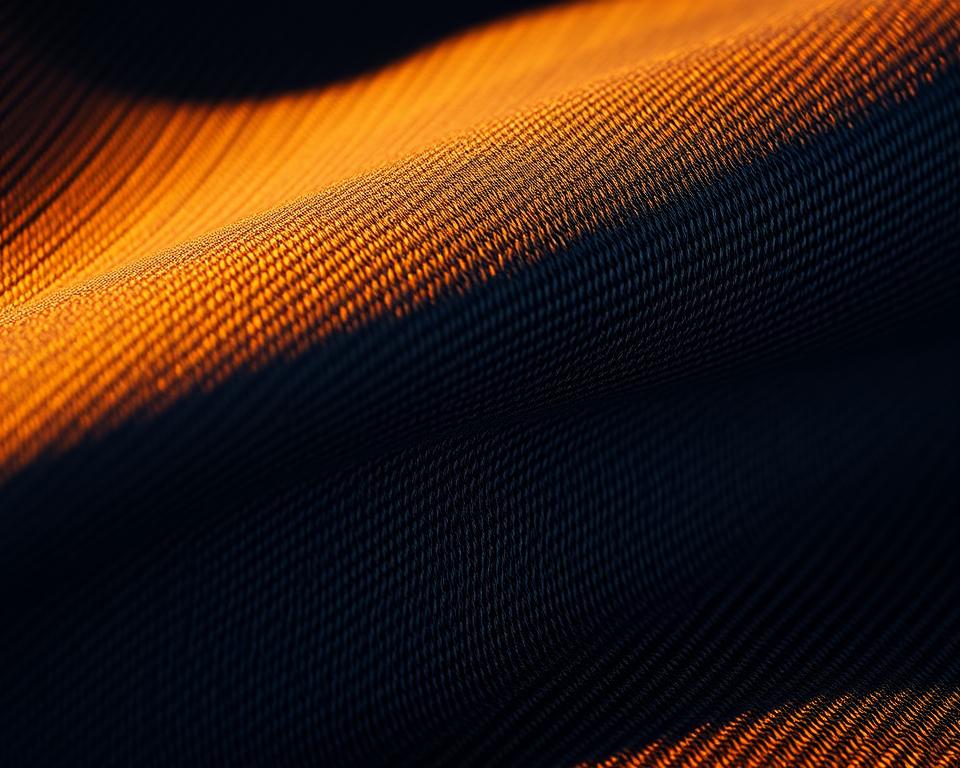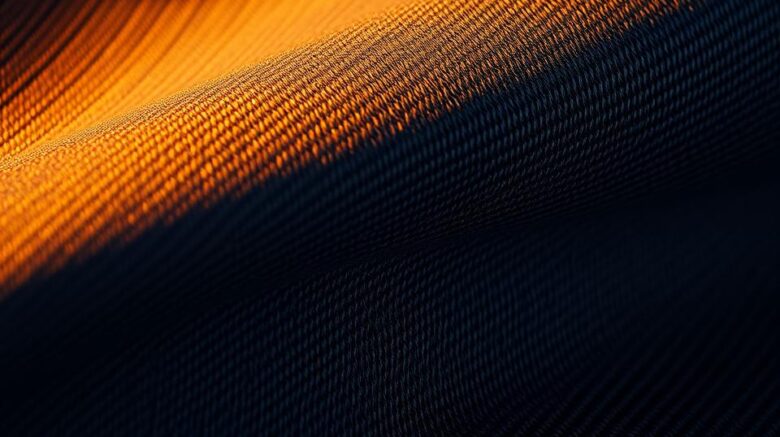A Comprehensive Guide to Premium denim Edge-to-Edge Textile
Have you ever questioned why certain jeans feel like they’re designed for longevity eternity? Everything revolves around the components and craftsmanship. Consider the increasing movement of superior selvedge. This goes beyond common material—it attests to superiority and legacy.
Nowadays, more people are choosing these everlasting textiles for their sturdiness and traditional selvedge denim by the yard appeal. Be it that you are a home sewing sewist or a denim aficionado, there’s something special about working with top-grade cotton and thread. It goes beyond merely making jeans; it involves fashioning a narrative.
At Core Fabrics, we’ve assembled a range of 14.25oz organic cotton and flexible variants. These materials are ideal for a spectrum ranging from raw trousers to high-fashion jacket patterns. Ready to explore the universe of premium fabrics? Let us delve in.
Understanding Denim Selvedge Fabric?
Why do certain trousers distinguish themselves with their unique, naturally edged seams? The answer is found in the selvedge denim, a superior textile renowned for its durability and old-school charm. Differing from conventional textiles, this fabric is produced using classic methods that have endured through ages.
Understanding Selvedge Denim
Selvedge denim is manufactured via retro shuttle looms, which produce slender widths of about 30-35 inches. They intertwine the material in a method that delivers self-finished borders, often accented with a characteristic red line. Such a process guarantees the material is firmly crafted and exceptionally sturdy.
Contemporary looms, in contrast, yield wider material but lack the comparable degree of skill. Minor flaws in selvedge, like misaligned seams or uneven textures, are celebrated as elements of its beauty. This approach, known as “wabi-sabi”, exalts the beauty of organic flaws.
How Selvedge Denim Is Made
The manufacturing of selvedge denim entails a meticulous process. These looms interlace the filling yarns back and forth, forming a thick and resilient material. This process stands in contrast with new-age looms, which emphasize quick production and efficiency over quality.
Labels such as Karson Denim maintain vintage Japanese methods from the nineteen-nineties. They deliberately incorporate anomalies to maintain the genuineness of the textile. Each piece is evaluated on a four-point system, ensuring it meets the top criteria of quality.
| Feature | Selvedge Denim | Current Denim |
|---|---|---|
| Width | 30-35 inches | 60+ inches |
| Fabrication Method | Classic Shuttle Loom | Contemporary Loom |
| Surface | Irregular, Flawed | Uniform |
| Sturdiness | High | Moderate |
“The beauty of selvedge resides in its natural irregularities—each irregularity speaks of artistry and heritage.”
The History of Selvedge Denim
From humble beginnings to international fame, the narrative of these materials is vibrant and motivational. What started as hardwearing clothing in 17th-century France has become a mark of timeless style and artistry.
Beginnings in Craftsmanship
The roots of this material reaches back to Nîmes, France, where it was known as “serge de Nîmes.” First intended for the working class, it was crafted out of hardwearing cotton and yarn. Its durability made it a favorite among the workforce during the era of the Gold Rush.
By the 20th century, it had become a cornerstone for jeans. The shuttering of the Cone Mills White Oak facility became a pivotal moment. This transition enabled Japanese artisans to revive traditional weaving techniques.

Evolution in Modern Denim Production
Post-WWII, Japan embraced old-school American culture. Artisans repaired old looms to create authentic reproductions. This dedication to craftsmanship ensured the perseverance of selvedge as a unique product.
Today, breakthroughs from Italy and Turkey have launched sustainable mixtures and flexible options. These modernizations have widened the attraction of this everlasting textile. At Core Fabrics, we gather worldwide, from Montréal to Asia, to deliver to you the best standards.
“The history of selvedge is a celebration of the enduring value of excellence and heritage.”
The Benefits of Selvedge Denim?
What makes selvedge denim distinguish itself in the world of premium materials? Its distinct attributes and unmatched durability have made it beloved among lovers and creatives alike. Be it that you are crafting jeans or a structured jacket, this material delivers a blend of tradition and updated style.
Unique Qualities of Selvedge Fabric
Selvedge denim is known for its tight weave, which enhances ripping resistance and wear patterns. In contrast to common fabrics, rainbow selvedge denim is crafted using classic shuttle looms, yielding a more compact and more durable fabric. In doing so, it secures that each piece has a singular finish and character.
Notable attributes are:
- Coarse, stiff raw denim contrasts with softened, pre-washed stretch fabrics.
- Through sanforization, sizes become reliable, while untreated fabrics provide a dynamic fitting process.
- Available weights span from 9.5oz Eco Finish to 14.25oz Organic, catering to diverse applications.
Durability and Longevity
One of the most remarkable aspects of selvedge denim is its enduring nature. The tighter weave boosts robustness while enabling distinctive color fades over time. This makes it a wise purchase for those in pursuit of classic garments.
Key points to consider:
- Fabrics weighing between 12oz and 14oz are perfect for form-fitting jackets and jeans that mellow with time.
- Opt for the 14.25oz True Indigo for traditional jean lifespan.
- Sustainable variants such as recycled cotton combined with indigo blends enhance eco-friendliness.
Within our range at Core Fabrics, diverse choices cater to distinct demands. Spanning from raw finishes to sanforized treatments, each selection is designed for superior quality and value.
Comparing Selvedge and Wide Denim
For making durable and stylish garments, the choice of material is pivotal. Two common choices include selvedge and wide denim, both offering different features. Comprehending their variances guides the right one for your endeavor.
Distinct Weaving Methods
Selvedge denim is crafted with time-honored shuttle looms, resulting in limited spans of 30-35 inches. This selvedge denim jacket process creates secure finishes, often accented with a distinctive red line. In contrast, wide denim is produced using modern projectile looms, producing spans of 60+ inches.
Old-style shuttle looms yield roughly 3m per minute, while contemporary projectile looms achieve up to 30m per minute. The variance in production speed affects both the expense and the texture of the final product.
Pros and Cons of Each Type
Selvedge denim is celebrated for its superior quality and strength. Its narrow width suits it well for projects where exposed edges or decorative patches are required. However, it can be pricier, generally priced at $23 per meter.
Wide denim is economical, typically costing $8 per half-meter. Its wider width cuts down on scrap, making it suitable for big-scale works like furniture covering. However, it falls short of the signature finished border of selvedge.
| Feature | Selvedge Denim | Wide Denim |
|---|---|---|
| Width | 30-35 inches | 60+ inches |
| Technique | Traditional Shuttle | Projectile Loom |
| Production Speed | 3m per minute | 30 meters per minute |
| Expense | $23/meter | $8/half-meter |
For defined borders as seen in Grainline Thayer jackets, selvedge is favored. Conversely, wide denim is ideal for extensive projects due to its efficiency. Weigh your requirements carefully to decide.
How to Use Selvedge Denim
Working with premium materials can elevate your sewing projects to the next level. Whether you are creating jeans, blazers, or frocks, grasping fabric quantities, proper sewing methods, and maintenance guarantees a polished result. Let’s delve into how to make the most of this timeless fabric.
Material Requirements for Jeans and Jackets
When planning your project, calculating the right amount of material is crucial. Men’s jeans typically require roughly 3-3.3 yards, factoring in flaws and potential shrinkage. For trucker jackets, expect to use around 3.3 yards, while skirts require only 2 yards.
Creative pattern placement can help manage imperfections in the material. Rather than avoiding imperfections, incorporate them into your pattern for distinctive style.
| Item | Required Yardage |
|---|---|
| Jeans for Men | 3–3.3 yards |
| Trucker Jacket | 3.3 yards |
| Dress | 2 yards |
Sewing Techniques and Maintenance
Using the right tools and techniques ensures a polished result. Select #70–110 pins and machine attachments suitable for thick fabrics. Gütermann rPET thread works well for contrasting stitches.
Additional advice includes:
- A tailor’s clapper helps deliver defined creases without unwanted shine.
- Core Fabrics provides denim kits with topstitch thread, rivets, and 9mm buttons for that expert touch.
- When sturdy borders are needed, such as in jackets, selvedge is optimal.
Correct care ensures your garments last longer. Wash sparingly and air dry to maintain the material’s integrity. Following these guidelines guarantees enduring results.
Final Remarks
Using superior fabrics goes beyond mere durability—it’s about instilling personality. Selvedge denim exemplifies this ideology, blending handcrafted appeal with enduring excellence. Whether you’re sewing jeans or a structured jacket, this material tells a story with every stitch.
At Core Fabrics, we make it easy to explore your creativity. Try our swatch service to feel the texture and weight before committing. Plus, enjoy free shipping on orders over $150 USD across North America.
Future trends in cotton textiles include sustainable blends and retro washes. Such innovations provide novel methods for infusing eco-consciousness and fashion into your closet.
Ready to dive into the world of premium materials? Begin your journey now and appreciate the merit of intentional crafting. Your future project might just be that lasting masterpiece.
